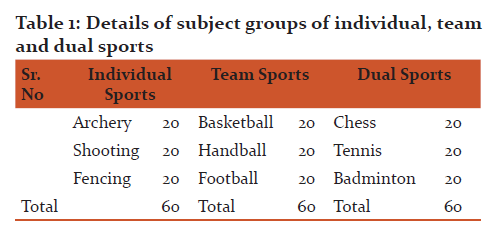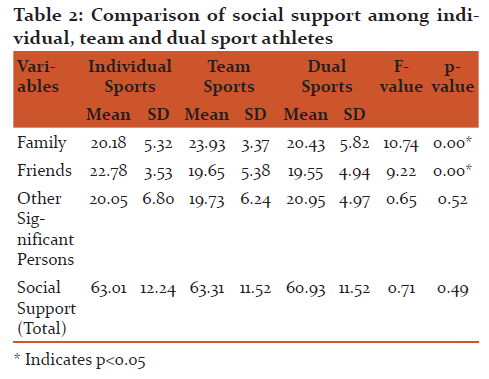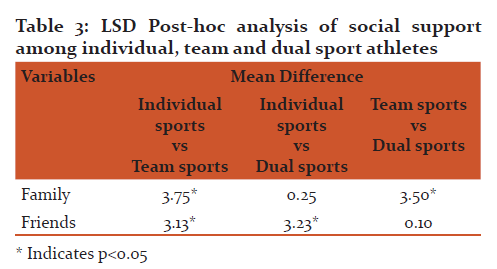IJCRR - 9(14), July, 2017
Pages: 19-22
Date of Publication: 28-Jul-2017
Print Article
Download XML Download PDF
Comparative Study of Social Support among Individual, Team and Dual Sports Athletes
Author: Amandeep Singh, Amritpreet Singh
Category: Healthcare
Abstract:Aim: The aim of present study was to compare the social support among individual, team and dual sports athletes.
Methodology: For this purpose, the investigators had selected one hundred eighty (Individual sport=60, Team sport=60, Dual sport=60) male inter-college individual, team and dual sports athletes between the age 17-28 years as subjects. All the subjects were assessed for social support with the help of Social Support Questionnaire given by Zimet et al. (1988).
Results: One-way analysis of variance (ANOVA) revealed that the individual, team and dual sport athletes had significant differences on the sub-variables family (p< 0.05) and friends (p< 0.05). The LSD post-hoc analysis revealed that the team sport athletes were significantly better than the dual (p< 0.05) and individual (p< 0.05) sport athletes on the sub-variable family whereas the individual sport athletes were significantly better than the team (p< 0.05) and dual (p< 0.05) sport athletes on the sub-variable friends.
Conclusions: The individual, team and dual sport athletes were differed on the sub-variables family and friends. But no significant differences were reported among individual, team and dual sport athletes on social support (total)..
Keywords: Social Support, Players, Team Sport, Dual Sport, Athletes
DOI: 10.7324/IJCRR.2017.9145
Full Text:
INTRODUCTION
Sports psychology is the scientific study of mind, emotion, and behavior as it relates to athletic performance and physical activity. The mental demands of rigorous competition can be enormous, making sports psychology a crucial part of any athlete’s training regimen. Psycho-social factors played an important role in the performance and well-being of athletes. Athletes need the positive support of teammates, coaches, parents and friends especially when the athlete feels that he/she is not performing well or realizing his/her potential (Weinberg and Gould, 2003). Social support is a multi-dimensional construct (Udry, 1996) which allows for many possible providers of support as well as various forms. Expressing emotional support, tangible support, informational support and esteem support are all examples of supportive social behaviours (Albrecht and Adelman, 1984).
Social support is often used in a broad sense, including social integration. However, Social integration refers to the structure and quantity of social relationships, such as the size and density of networks and the frequency of interaction, but also sometimes to the subjective perception of embeddedness. There have been recent indications that social support resources play an important role in athlete retention and success (Botterill, 2004). Social support is associated with better psychological health in general and reduces the negative psychological consequences of exposure to stressful life events (Cohen and Wills, 1985). Social support has also been defined as a those social interactions or relationships that individuals with actual assistance or that embed individuals within a social system believed to provide love, caring or sense of attachment to a valued social group (Hobfoll, 1988). Generally, social support refers to knowing that one is loved and cared for and that others will do all they can when a problem arises (Sarason, 1990). Wallston et al. (1983) reported that various sources or types of social support contribute to different outcomes in physical health. In recent years there have been many studies of the relationship among adjustment, social support, and psychological well-being or life satisfaction (Hardy et al, 1991; Malinauskas, 2008; Petrie, 1992, 1993; Ryska and Yin, 1999; Smith et al, 1990).
There have been recent indications that social support resources play an important role in athlete retention and success (Botterill, 2004; Bruner, 2002; Halliwell, 2004). Generally, social support refers to knowing that one is loved and cared for and that others will do all they can when a problem arises (Sarason et al., 1990). Sarason and colleagues concluded that the essence of social support lies in the individuals’ beliefs that they have valued providers who display concern, and are willing to assist in times of need. In sports, social support might influence performance by providing advice about tactics and game plans, or by increasing positive effect, leading to a greater likelihood of experiencing flow states (Cohen, 1988; Rees et al., 1999). Alternatively, social support might buffer the negative impact of stress on performance. Pines et al. (1981) suggested six types of social support offered by providers such as listening, emotional, emotional challenge, shared social reality, technical appreciation, and technical challenge. Rosenfeld and Richman (1997) proposed two additional support types viz. tangible assistance (providing financial assistance) and personal assistance (driving the athlete somewhere).
While considering the paramount importance of psychological variables with regard to sports, the present study aims to analyze and compare the social support in individual, team and dual sports athletes.
METHODOLOGY
For the purpose of the present study, one hundred eighty male inter-college individual, team and dual sports players between the age group of 17-28 years were selected as subjects. The subjects were purposively selected from various colleges of Guru Nanak Dev University, Amritsar. The subjects include 60 individual sports athletes, 60 team sports players and 60 dual sports players. All the subjects, after having been informed about the objective and protocol of the study, gave their consent and volunteered to participate in this study.

Social Support
The social support among the individual, team and dual sport athletes was assessed with the help of Social Support Questionnaire given by Zimet et al. (1988). Multi Dimensional Perceived Social Support is 12 items instrument that measure an individual’s perceived level of social support. It is designed to assess perceptions of social support adequacy from specific sources, family, friends and significant others. Participate were asked to rate their perceived level of social support on a seven Likert scale from 1 very strongly disagree to 7 very strongly agree. The whole scale has 12 items score can range from 1-84 (higher scores indicating a greater level of social support.
It has been found that overall score and the scores for subscale (family, friend and significant others) separately show acceptable published test-retest reliability, factors of validity and construct validity. Significant others and friends factors were found to be more moderately correlates (r= .63), the family subscale was found to be more independence from the other, with correlations of (.24) and (.34) with significant others and friend, respectively. Further reliability ranged from .84 to .92 for the scale as a whole.
Factors of Social Support
- Family: family is measured by item 3, 4,8,11. These items are “My family really tries to help me”, “I get the emotional help and support I need from my family”, “I can talk about my problems with my family” and “My family is willing to help me make decisions”.
- Friends: friends are measured by item 6, 7,9,12. These items are “My friends really try to help me”, “I can count my friends when things go wrong”, “I have friends with whom I can share my joys and sorrows” and “I can talk about my problems with my friends”.
- Other significant persons: other significant persons are measured by items 1, 2,5,10. These items are “There is a special person around when I am in need”, There is a special person with whom I can share my joys and sorrows”, I have a special person who is a real source of comfort to me” and “There is special person in my life that who cares about my feelings”.
Scoring: The present scale is a multiple choice responses presented in a continuous responses range from very strongly disagree, strongly disagree, mildly disagree, neutral, mildly agree, strongly agree to very strongly agree. In this seven point scale, the responses are given weight from 1 to 7 as shown below. Therefore, a higher score reflects better social support.
Statistical Analysis
One Way Analysis of Variance (ANOVA) was employed to compare the level of social support among individual, team and dual sports athletes. Where ‘F’ values were found significant, LSD (Least Significant Difference) Post-hoc test was applied to find out the direction and degree of difference. For testing the hypotheses, the level of significance was set at 0.05.
RESULTS


Table 2 presents the descriptive statistics and F-values of the social support and sub-variables of social support viz. family, friends and other significant persons of the individual, team and dual sport athletes. Table 3 presents the LSD (Least Significant Difference) Post-hoc analysis of sub-variables of social support among individual, team and dual sport athletes. The results revealed that there were significant differences (F=10.74, p=0.00) among the individual, team and dual sport athletes on the sub-variable family. Team sport athletes were found to have highest mean value on sub-variable family followed by dual and individual sport athletes respectively. The LSD post-hoc analysis revealed that the team sport athletes were significantly better than the dual (p<0.05) and individual (p<0.05) sport athletes on the sub-variable family. Similarly, significant differences (F=9.22, p=0.00) were reported among the individual, team and dual sport athletes on the sub-variable friends. Individual sport athletes were found to have highest mean value on sub-variable friends followed by team and dual sport athletes respectively. The LSD post-hoc analysis revealed that the individual sport athletes were significantly better than the team (p<0.05) and dual (p<0.05) sport athletes on the sub-variable friends. However, no significant differences were reported among individual, team and dual sport athletes on the sub-variable other significant persons and social support (total).
DISCUSSION
Social support is the comfort, assistance, well-being, and information that individuals receive from formal or informal contacts with societal organization or the other people (Cohen et al., 2000). While it is clear that there are many factors associated with talent development, social support has emerged as a commonly cited socio-contextual factor for athletes at many competitive levels (Bianco and Eklund, 2001; Giacobbi et al., 2004; Holt and Dunn, 2004; Rees and Hardy, 2000; Reinboth et al., 2004; Scanlan et al, 2003). In the present study, no significant differences were reported among individual, team and dual sports athletes in relation to social support. These findings suggest that the social support is equally important in all sports. The social nature of sport implies that social support may be an important source of confidence (Babkes and Partridge, 2004). However, sub-variables of the social support viz. family and friend showed significant differences among individual, team and dual sports athletes. Team sport athletes had greater family support than the dual and individual sport athletes whereas the individual sport athletes had greater support from friends than the team and dual sport athletes. Previous studies have found that specific ways that parents provide support may be more influential than overall support provided (Beets and Petetti, 2007). Lack of parental encouragement, lack of role models and increased social pressure contributes to lower self-confidence and self-efficacy among athletes (Bunker et al., 1997; Sabo et al., 2004). There is evidence that social support is linked to elements of motivation (Reinboth et al., 2004) and commitment (Scanlan et al., 2003). In a study on rugby players, Scanlan et al. (2003) demonstrated the importance of encouragement and support among family and extended family in the lives of world-class rugby players. Morgan and Giacobbi’s (2006) reported that social support from family, coaches and teammates emerged as indispensable among collegiate athletes. However, there were no significant differences among individual, team and dual sport athletes on the sub-variable other significant persons. According to Eccles et al. (1998) significant others can affect a young athlete’s self-perceptions, attitudes, values, beliefs and behaviors. Athletes’ relationships with influential people played a role in their ability to face and overcome adversities during their athletic career (Giacobbi et al., 2004; Holt and Dunn, 2004).
CONCLUSIONS
The individual, team and dual sport athletes had significant differences on the sub-variables family and friends. The team sport athletes were significantly better than the dual and individual sport athletes on the sub-variable family whereas the individual sport athletes were significantly better than the team and dual sport athletes on the sub-variable friends. No significant differences were found among individual, team and dual sport athletes on social support.
References:
- Albrecht, T.L. and Adelman, M.B. (1984) Social support and life stress: New directions for communication research. Human Communication Research, 11:3-22.
- Babkes, M.L. and Partridge, J.A. (2004). Social influence on emotion in sport. In D. Lavallee, J. Thatcher, and M. Jones (Eds.), Coping and emotion in sport (pp. 145-166). Hauppauge, NY: Nova Science.
- Beets, M.W. and Pitetti, K.H. (2007). The role of self-efficacy and referent specific social support in promoting rural adolescent girls’ physical activity. American Journal of Health Behaviour, 31(3):227-237.
- Bianco, T. and Eklund, R.C. (2001). Conceptual considerations for social support research in sport and exercise settings: The case of sport injury. Journal of Sport and Exercise Psychology, 23:85-107.
- Botterill, C. (2004). The Psychology of Professional Hockey. Athletic Insight, 6(2). Retrieved from URL: http://www.athleticinsight.com/ Vol6Iss2 /Professional Hockey.htm.
- Bruner, M. (2002). An investigation of the cognitive, social, and emotional development of major junior OHL hockey players. Unpublished master's thesis document, University of Windsor, Windsor, Ontario, Canada.
- Bunker, L., Margaret, C.D., Freedson, P., Greenberg, D., Oglesby, C., Sabo, D. and Wiese- Bjornstal. (1997). Physical activity and sport in the lives of girls: Physical and mental health dimensions form an interdisciplinary approach. Washington, DC: President’s Council on Physical Fitness and Sport.
- Cohen, S. (1988). Psychosocial models of the role of social support in the etiology of physical disease. Health Psychology 7:269-297.
- Cohen, S. and Wills, T. A. (1985). Stress, social support, and the buffering hypothesis. Psychological Bulletin, 98:310–357.
- Cohen, S., Underwood, L.G. and Gottlieb, B.H. (2000). Social Support Measurement and Intervention. New York: Oxford University Press.
- Eccles, J.S., Wigfield, A. and Schiefele, U. (1998). Motivation to succeed. In N. Eisenberg and W. Damon (Eds.), Handbook of Child Psychology (5th ed., pp. 1051-1071). New York: Wiley.
- Giacobbi, P.R., Lynn, T.K., Wetherington, J., Jenkins, J., Bodendorf, M. and Langley, B. (2004). Stress and coping during the transition to university for first-year female athletes. The Sport Psychologist, 18:1-20.
- Halliwell, W. (2004) Preparing professional hockey players for player performance. AthleticInsight. Available:URL:www.athleticinsight.com/Vol6Iss2/ProfessionalHockeyPlayoffPerformance.htm.
- Hardy, C. J., Richman, J. M. and Rosenfeld, L. B. (1991). The role of social support in the life stress/injury relationship. Sport Psychologist, 5:128-139.
- Hobfoll, S.E. (1988). The Ecology of Stress. Washington. D.C: Hemisphere.
- Holt, N.L. and Dunn, J.G.H. (2004). Toward a grounded theory of the psychosocial competencies and environmental conditions associated with soccer success. Journal of Applied Sport Psychology, 16:199-219.
- Malinauskas, R. (2008). College athletes’ perception of social support provided by their head coach before injury and after it. Journal of Sports Medicine and Physical Fitness, 48:107-112.
- Morgan, T.K. and Giacobbi, P.R. (2006). Toward two grounded theories of the talent development and social support process of highly successful collegiate athletes. The Sport Psychologist, 20:295-313.
- Petrie, T. A. (1992). Psychosocial antecedents of athletic injury: The effects of life stress and social support on women collegiate gymnasts. Behavioral Medicine, 18:127-138.
- Petrie, T. A. (1993). The moderating effects of social support and the playing status on the life stress-injury relationship. Journal of Applied Sport Psychology, 5(1):1-16.
- Pines, A., Aronson, E. and Kafry, D. (1981). Burnout. New York: Free Press.
- Rees, T. and Hardy, L. (2000). An investigation of the social support experiences of high-level sports performers. The Sport Psychologist, 14:327-347.
- Rees, T., Ingledew, D.K. and Hardy, L. (1999). Social support dimensions and components of performance in tennis. Journal of Sports Sciences, 17:421-429.
- Reinboth, M., Duda, J. and Ntoumanis, N. (2004). Dimensions of coaching behaviour, need satisfaction and psychological and physical welfare of young athletes. Motivation and Emotion, 28:297-343.
- Rosenfeld, L.B. and Richman, J.R. (1997). Developing effective social support: Team building and the social support process. Journal of Applied Sport Psychology, 9:133-153.
- Ryska, T.A. and Yin, Z. (1999). Testing the buffering hypothesis: perceptions of coach support and pre-competitive anxiety among male and female high school athletes. Current Psychology, 18(4):381-393.
- Sabo, D., Miller, K.E., Melnick, M.J. and Heywood, L. (2004). Her life depends on it: Sport, physical activity, and the health and well-being of American girls. East Meadows, NY: Women’s Sports Foundation.
- Sarason, B.R., Sarason, I.G. and Pierce, G.R. (1990). Social Support: An interactional view. New York: Wiley.
- Scanlan, T. K., Russell, D. G., Beals, K. P. and Scanlan, L. A. (2003). Project on Elite Athlete Commitment (PEAK): II. A direct test and expansion of the Sport Commitment Model with elite amateur sportsmen. Journal of Sport and Exercise Psychology, 25:377-401.
- Smith, R.E., Smoll, F.L. and Ptacek, J.T. (1990). Conjunctive moderator variables in vulnerability and resiliency research: life stress, social support and coping skills, and adolescent sport injuries. Journal of Personality and Social Psychology, 58(2):360 - 370.
- Udry, E.M. (1996). Social support: Exploring its role in the context of athletic injuries. Journal of Sport Rehabilitation, 5:151-163.
- Wallston, B.S., Alagna, S.W., DeVellis, B.M. and Dvellis, R.F. (1983). Social support and physical health. Health Psychology, 2(1):367-391.
- Weinberg, R.S. and Gould, D. (2003). Foundations of sport and exercise psychology (3rd ed). Champaign, IL: Human Kinetics.
- Zimet, G.D., Dahlem, N.W., Zimet, S.G. and Farley, G.K. (1988). The Multidimensional Scale of Perceived Social Support. Journal of Personality Assessment, 52(1):30-41.
|






 This work is licensed under a Creative Commons Attribution-NonCommercial 4.0 International License
This work is licensed under a Creative Commons Attribution-NonCommercial 4.0 International License